
Circe, minor planet designation 34 Circe, is a large, very dark main-belt asteroid. It was discovered by French astronomer J. Chacornac on April 6, 1855, and named after Circe, the bewitching queen of Aeaea island in Greek mythology.

Leukothea is a large, dark asteroid from the asteroid belt. It was discovered by German astronomer Karl Theodor Robert Luther on April 19, 1855, and named after Leukothea, a sea goddess in Greek mythology. 35 Leukothea is a C-type asteroid in the Tholen classification system, suggesting a carbonaceous composition. It is orbiting the Sun with a period of 5.17 years and has a cross-sectional size of 103.1 km.

Atalante is a large, dark main-belt asteroid. It was discovered by the German-French astronomer H. Goldschmidt on October 5, 1855, and named by French mathematician Urbain Le Verrier after the Greek mythological heroine Atalanta. It was rendered 'Atalanta' in English sources in the 19th century. This asteroid is classified as C-type (carbonaceous), according to the Tholen classification system.

Leda is a large, dark main-belt asteroid that was discovered by French astronomer J. Chacornac on January 12, 1856, and named after Leda, the mother of Helen of Troy in Greek mythology. In the Tholen classification system, it is categorized as a carbonaceous C-type asteroid, while the Bus asteroid taxonomy system lists it as a Cgh asteroid. The spectra of the asteroid displays evidence of aqueous alteration.
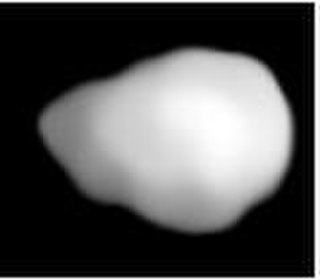
Daphne is a large asteroid from the asteroid belt. It is a dark-surfaced body 174 km in diameter is probably composed of primitive carbonaceous chondrites. The spectra of the asteroid displays evidence of aqueous alteration. It was discovered by H. Goldschmidt on May 22, 1856, and named after Daphne, the nymph in Greek mythology who was turned into a laurel tree. Incorrect orbital calculations initially resulted in 56 Melete being mistaken for a second sighting of Daphne. Daphne was not sighted again until August 31, 1862.

Alexandra is a carbonaceous asteroid from the intermediate asteroid belt, approximately 155 kilometers in diameter. It was discovered by German-French astronomer Hermann Goldschmidt on 10 September 1858, and named after the German explorer Alexander von Humboldt; it was the first asteroid to be named after a male.

Galatea is a large C-type main-belt asteroid. Its carbonaceous surface is very dark in color with an albedo of just 0.034. Galatea was found by the prolific comet discoverer Ernst Tempel on August 29, 1862, in Marseilles, France. It was his third asteroid discovery. It is named after one of the two Galateas in Greek mythology. A stellar occultation by Galatea was observed on September 8, 1987. The name Galatea has also been given to one of Neptune's satellites.

Artemis is a main-belt asteroid that was discovered by J. C. Watson on September 16, 1868, at Ann Arbor, Michigan. It was named after Artemis, the goddess of the hunt, Moon, and crossways in Greek Mythology.

137 Meliboea is a large, dark main-belt asteroid that was discovered by Austrian astronomer J. Palisa at the Austrian Naval Observatory on 21 April 1874, the second of his many asteroid discoveries. It was later named after Meliboea, the daughter of Oceanus and Tethys in Greek mythology. The largest body in the Meliboea family of asteroids that share similar orbital elements, only 791 Ani approaches its size. It is classified as a C-type asteroid and may be composed of carbonaceous materials. The spectra of the asteroid displays evidence of aqueous alteration.
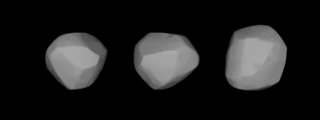
Lucina is a main-belt asteroid that was discovered by Alphonse Borrelly on June 8, 1875, and named after Lucina, the Roman goddess of childbirth. It is large, dark and has a carbonaceous composition. The spectra of the asteroid displays evidence of aqueous alteration.

161 Athor is an M-type Main belt asteroid that was discovered by James Craig Watson on April 19, 1876, at the Detroit Observatory and named after Hathor, an Egyptian fertility goddess. It is the namesake of a proposed Athor asteroid family, estimated to be ~3 billion years old.

168 Sibylla is a large main-belt asteroid, discovered by Canadian-American astronomer J. C. Watson on September 28, 1876. It was most likely named for the Sibyls, referring to the Ancient Greek female oracles. Based upon its spectrum this object is classified as a C-type asteroid, which indicates it is very dark and composed of primitive carbonaceous materials. 168 Sibylla is a Cybele asteroid, orbiting beyond most of the main-belt asteroids.
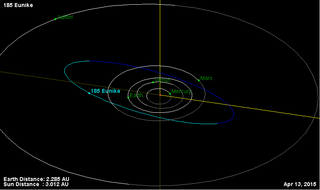
Eunike is a dark and very large main-belt asteroid, with an approximate diameter of 157 kilometres. It has a primitive carbonaceous composition.

Dynamene is a large dark main-belt asteroid that was discovered by German-American astronomer Christian Heinrich Friedrich Peters on July 27, 1879, in Clinton, New York. The name derives from Dynamene, one of the fifty Nereids in Greek mythology. Based upon its spectrum, 200 Dynamene is classified as a C-type asteroid, indicating that it probably has a primitive composition similar to the carbonaceous chondrite meteorites. The spectra of the asteroid displays evidence of aqueous alteration.
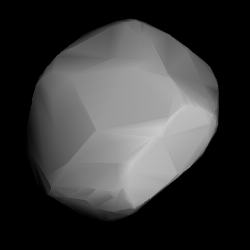
Hypatia is a very large main-belt asteroid that was discovered by Russian astronomer Viktor Knorre on July 1, 1884, in Berlin. It was the third of his four asteroid discoveries. The name was given in honour of philosopher Hypatia of Alexandria. Based upon the spectrum, it is classified as a C-type asteroid and is probably composed of primitive carbonaceous material. Like many asteroids of this type, its surface is very dark in colour.

Etheridgea is a large main belt asteroid. It was discovered by Auguste Charlois on 1 April 1892 in Nice. The meaning of the name is unknown. This asteroid is orbiting the Sun at a distance of 3.02 AU with a period of 5.26 years and an eccentricity (ovalness) of 0.10. The orbital plane is tilted at an angle of 6.05° to the plane of the ecliptic.

706 Hirundo is an elongated background asteroid, located in the central region of the asteroid belt. It was discovered by German astronomer Joseph Helffrich at the Heidelberg Observatory on 9 October 1910. The carbonaceous C-type asteroid (Cgh) has a rotation period of 22.0 hours and measures approximately 30 kilometers in diameter. It was named after the bird genus Hirundo, commonly known as swallows.
777 Gutemberga is a dark and large background asteroid, approximately 66 kilometers in diameter, from the outer regions of the asteroid belt. It was discovered by German astronomer Franz Kaiser at the Heidelberg-Königstuhl State Observatory on 24 January 1914. The carbonaceous C-type asteroid (Cb) has a rotation period of 12.8 hours. It was named after Johannes Gutenberg, who introduced the printing press to Europe and started the Printing Revolution.
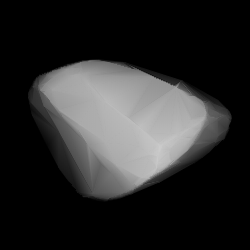
784 Pickeringia is a large background asteroid, approximately 76 kilometers in diameter, located in the outer region of the asteroid belt. It was discovered on 20 March 1914, by American astronomer Joel Hastings Metcalf at the Winchester Observatory in Massachusetts. The dark C-type asteroid has a rotation period of 13.1 hours and an irregular shape. It was named after American astronomers Edward Charles Pickering (1846–1919) and his brother William Henry Pickering (1858–1938).
4585 Ainonai is a dark Chloris asteroid, approximately 11 kilometers in diameter, located in the central region of the asteroid belt. It was discovered on 16 May 1990, by Japanese amateur astronomers Kin Endate and Kazuro Watanabe at the Kitami Observatory in eastern Hokkaidō, Japan. The presumed carbonaceous C-type asteroid has a longer than average rotation period of 38.3 hours. It was named for the Japanese town of Ainonai, located near the discovering observatory.


















